Local judges (1) - stipendiary magistrates
Here are some details of those who held office at the Lambeth Street
and Thames Police (Magistrates') Courts, and at Whitechapel County
Court. It demonstrates the shift from 'gentlemen' (those who had been
county JPs before 1792) to a professional caste of barristers. It is
also interesting to compare them with the clergy who held
office locally as incumbents: they too were 'Oxbridge men', some of
them from quite
grand families, some with homes in the country, but did not have the
generous stipends of the judges, and they lived on their patch rather
than
in the West End. Cushioned from the rigours of East End existence,
how much understanding did some of them have of the lives of those who
appeared before them?
The best of them showed a degree of realism - and the worst of them
exploited their position - but almost all were inevitably more aloof
than the
clergy.
The dates in brackets for the years they were attached to particular
courts are somewhat approximate, as lists of the time can be confusing,
and some were attached to more than one London court -
particularly the Shadwell magistrates, who tended also to sit at Queen
Square, Westminster or Hatton Garden (perhaps an indication that this
court, which closed in 1821, was less busy, since the Thames (Marine
Police) court was nearby). Some were also provincial county
magistrates. In the house of was the legal phrase at the time for a sucessor in office following a death, retirement or promotion.
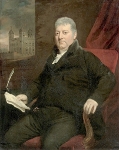 Lambeth Street (1792-1844)
Lambeth Street (1792-1844)
Sir Daniel Williams (1792-1831)
was
the first presiding magistrate at the new court; his nefarious
activities in connection with the licensing laws and other
opportunities for profit are considered here. He was also a Lieutenant Colonel of the 1st Tower Hamlets
Militia and was painted [right] by John Opie (1761-1817) with the Tower in the background. He died in 1831 at his home in Stamford Hill. His namesake son Daniel served on HMS Agamemnon, and was taken prisoner: this letter of Horatio Nelson refers.
Rice Davies (1792-1818) - born 1741; granted a pension of £400 in 1818 (and wanted his arms - presumably hanging in the courtoom!), but died later that year at Neath, Glamorgan. He was replaced by one Munshell [details needed].
Henry
Reynott DD (1792-18??) - see comments here about a Doctor of Divinity's suitability for this post; a relative, Sir James Henry Reynott, was Governor of Jersey
a generation later.
[Another local clerical magistrate of a slightly later period,
appointed as a Middlesex JP in 1821, and sometimes 'assisting' at
Lambeth Street, was the Revd Daniell Mathias
MA (1769-1837), born in Warrington, and a former Fellow of Brasenose
College Oxford who appointed him Rector of St Mary Whitechapel in 1809.
He was energetic in developing schools, for which he published an Explanation of the Church Catechism. His 1837 obituary in the Gentleman's Magazine said he was eminent
for his great skill in separating truth from falsehood, and for his
tact in the examination of witnesses. Mr Mathias made his knowledge of
law subservient to the interests of the religion of which he was the
minister; and from the bench, as well as from the pulpit, he delivered
sentiments calculated to improve base humanity - hardly good
legal practice; and contrast this with a case he heard at Lambeth
Street in 1824, when a rabbi accused Joseph Jones, a donkey driver, of
attempted assault on his daughter Leah Meldola, by forcing her into a
nearby house to eat pork. Mathias summarily dismissed the case as frivolous, reprimanding them for wasting the court's time and describing Jews as a quarrelling people.]
Matthew Wyatt
(1773-1831), barrister of the Inner Temple, was also a magistrate in
Roscommon, Ireland; his sons Thomas Henry and Matthew Digby were noted architects.
William Lorance Rogers FSA (1813-??)
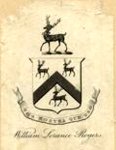
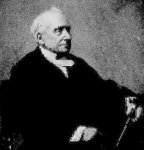 was
the second son of Captain John Rogers, and descendant of Captain John
Rogers who gained distinction by repelling the assault of a Biscay
privateer on a transport ship under his commend in 1704. He was called
to the Bar at the Middle Temple in 1805, but his chambers were
subsequently at 5 Old Square, Lincoln's Inn and his home in Upper
Bedford Place, Russell Square, and later in Hampstead. He was appointed
a magistrate in 1813, sitting at Hatton Garden as well as in the local
courts, and was a member of Fellow of the (Royal) Society of Arts and subscriber to the [science-based] Royal Institution and a bibliophile - bookplate right (motto nos nostraque deo = we and ours to God);
his extensive library was auctioned the year aftert his death in 1838. For a few years, from
1812-15, he was an elected member of 'Nobody's Friends', a dining club
established in 1800 by Richard Stevens (a high churchman and Treasurer
of Queen Anne's Bounty); its influential membership overlapped with the
'Hackney Phalanx' (also known as the 'Clapton sect', as distinct from
the evangelical 'Clapham sect') which had a particular interest in
education reform.
was
the second son of Captain John Rogers, and descendant of Captain John
Rogers who gained distinction by repelling the assault of a Biscay
privateer on a transport ship under his commend in 1704. He was called
to the Bar at the Middle Temple in 1805, but his chambers were
subsequently at 5 Old Square, Lincoln's Inn and his home in Upper
Bedford Place, Russell Square, and later in Hampstead. He was appointed
a magistrate in 1813, sitting at Hatton Garden as well as in the local
courts, and was a member of Fellow of the (Royal) Society of Arts and subscriber to the [science-based] Royal Institution and a bibliophile - bookplate right (motto nos nostraque deo = we and ours to God);
his extensive library was auctioned the year aftert his death in 1838. For a few years, from
1812-15, he was an elected member of 'Nobody's Friends', a dining club
established in 1800 by Richard Stevens (a high churchman and Treasurer
of Queen Anne's Bounty); its influential membership overlapped with the
'Hackney Phalanx' (also known as the 'Clapton sect', as distinct from
the evangelical 'Clapham sect') which had a particular interest in
education reform.
This was the area in which his son William (1819-96) rose to
distinction. (Another son Edward had died in 1829 aged twelve.)
Etonian, student of Balliol, barrister and Durham-trained clergyman,
William 'Hang Theology' Roberts [he was impatient with bickering over
the nature of religious instruction in schools] created a school for
children of the poor at his parish of St Thomas Charterhouse, and
schools for the middle classes when he became Rector of St
Botolph-without-Bishopsgate (and an early promoter of the Bishopsgate
Institute); he was a member of the 1858 Report on Popular Education, a
founding member of the London School Board in 1870 ( but resigned two
years later) and a proponent of free libraries - more details of his
life here,
and in this 1888 memoir by R.H. Hadden, formerly a curate at St
George-in-the-East and one of Rogers' successors at St Botolph's.
John Hardwick FRS (1821-41)
born in 1790, was the son of a well-known architect Thomas Hardwick. He was a Fellow of Balliol College Oxford (BCL and DCL), a barrister of Lincoln's Inn and a capital linguist according to the Illustrated London News of 9 October 1847 which thought this a most advantageous
quality in a 'police judge' presiding over a locality 'swarming with
foreigners' and whose applications for assistance from distressed Poles
and 'other expatriate unfortunates' were so frequent an occurrence.
He was appointed to
Lambeth Street in 1821; was elected Fellow of the Royal Society in
1838; and was a deputy lieutenant for Tower Hamlets. He transferred to
Great
Marlborough Street in 1841 and retired in 1856, living until 1875.
Charles Dickens - who with others such as Cobbett and Black had
campaigned against corruption among the London stipendiaries, causing
the removal of Alan Laing (the model for Mr Fang in Pickwick Papers)
- regarded 'Hardwick of Marlborough Street' as one of the best of the
London magistrates. They became friends, and Hardwick named candidates
for the Urania Cottage
project which Dickens and Angela Burdett-Coutts ran in Shepherd's Bush.
He was involved on various occasions with the prosecution of Ikey
Solomon, said to be Dicken's model for Fagin in Oliver Twist: see John Jacob Tobias Prince of Fences: the life and crimes of Ikey Solomons (1974).
Hardwick's work on 'police subjects' (including his appendix to editions of the late William Dickinson's Practical Exposition of the Law Relative to the Office and Duties of a Justice of the Peace, chiefly out of Session,
first published in 1813 and later running to eight volumes, price £2
14s) influenced the developing organisation of the Metropolitan Police.
Press complaints about the London magistrates continued: in 1846 the London Daily News commented on the discrepancies of punishment, observing that Any rich man may
enjoy the luxury of an assault by paying for it. The fine imposed is
the price of the article. The 'gentleman' buys his knockdown blow, or
wrenched knocker, or smashed lamp, at Bow-street; as he does his coat at Stultz's, or his boots at Host's; but did not apply this specifically to Hardwick. The 1847 article mentioned above said A rather elderly
mild-looking personage, he conducts the business in an
easy and conversational, yet by no means undignified, style and is not
above receiving a hint from any of the minor officials who surround him.
His wife was the
daughter of a colonel in the Swedish artillery. He died in Hove in
1875; The Times obituary noted the inflexible uprightness of his judgements and his extreme urbanity and courtesy of manner.
Thomas Walker
(1829-36)
son of a Manchester cotton merchant (also Thomas) who led the Whig cause
there and founded the Manchester Constitutional Society, and was accused but
acquitted of treason. Thomas junior, born in 1784, went to Trinity College Cambridge,
was called to the bar (Inner Temple) in 1812, and took a special interest in
poor law issues and published Observations on
the Nature, Extent, and Effects of Pauperism, and on the Means of
reducing it (1826 and 1831), and Suggestions for a
Constitutional and Efficient Reform in Parochial Government (1834). Appointed to Lambeth Street in 1829, from 1835 until his death
the following year (unmarried, in Brussels - there was a memorial
plaque in St Mary Whitechapel) he published a weekly journal The Original, intended to raise the national tone in whatever concerns
us socially or individually
but mainly concerned with health and gastronomy: selections on 'The Art
of Dining, and of attaining High Health', and 'Aristology, or the
Art of Dining' were republished in the coming years, with
biographies of father and son.
The Hon George Chapple Norton
(1831-54)
born in 1800, grandson of Baron Grantley, who was nicknamed 'Sir Bull-face
Double Fee' because of his success in geting government legal
appointments, and son of the well-paid Baron of the Exchequer in
Scotland, he attended Edinburgh University but does not appear to have
graduated. Through family connections, he became Tory MP for Guildford
1826-30, voting mainly with the party line. He was also appointed Recorder of
Guildford. His Whitechapel magistracy in 1831 (with a salary of £1,000)
debarred him from standing again for Parliament.
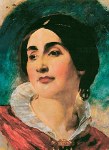
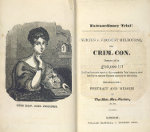

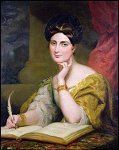 This post was fixed by
his wife Caroline [right, by George Hayer 1832], daughter of the playwright Sheridan, and herself a considerable
writer - with Lord Melbourne, the Home Secretary. Not only was
she from a family with Whig connections, but also mistress of widower
and philanderer Melbourne [right, by Landseer 1836]. Norton, although he protested undying love
for his childhood sweetheart, was in fact an appallingly violent and
abusive husband; they separated three times, but she returned for the
children's sake. Norton sued Melbourne, who had become Prime
Minister, in attempt to achieve a divorce. Melbourne was acquitted, but
many rash words were spoken by all parties and no-one emerged smelling
of roses [title page of a published version right]. Dickens drew on the case - and the farcical way the lovers'
correspondence was treated in court - for his Pickwick Papers.
Norton then exonerated his wife in an attempt to win her back, and
thereafter denied her a divorce; further washing of dirty linen
followed, and she became a campaigner for women's matrimonial rights in
marriage - leading to the Custody of Infants Act 1839 [far right, by Etty after this Act], the Matrimonial Causes Act 1857 and the Married Women's Property Act
1870. Nevertheless, he continued to hold his magistracy, transferring
to the Lambeth court in 1854, until he retired because of 'failing
health' in
1867, with pension, after 36 years on the bench; he died in 1875.
This post was fixed by
his wife Caroline [right, by George Hayer 1832], daughter of the playwright Sheridan, and herself a considerable
writer - with Lord Melbourne, the Home Secretary. Not only was
she from a family with Whig connections, but also mistress of widower
and philanderer Melbourne [right, by Landseer 1836]. Norton, although he protested undying love
for his childhood sweetheart, was in fact an appallingly violent and
abusive husband; they separated three times, but she returned for the
children's sake. Norton sued Melbourne, who had become Prime
Minister, in attempt to achieve a divorce. Melbourne was acquitted, but
many rash words were spoken by all parties and no-one emerged smelling
of roses [title page of a published version right]. Dickens drew on the case - and the farcical way the lovers'
correspondence was treated in court - for his Pickwick Papers.
Norton then exonerated his wife in an attempt to win her back, and
thereafter denied her a divorce; further washing of dirty linen
followed, and she became a campaigner for women's matrimonial rights in
marriage - leading to the Custody of Infants Act 1839 [far right, by Etty after this Act], the Matrimonial Causes Act 1857 and the Married Women's Property Act
1870. Nevertheless, he continued to hold his magistracy, transferring
to the Lambeth court in 1854, until he retired because of 'failing
health' in
1867, with pension, after 36 years on the bench; he died in 1875.
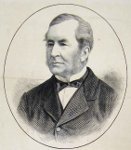 Sir Thomas
Henry (1840-46) - right:
an Irish Roman Catholic, born 1807, graduate of Trinity College Dublin, called to
the Bar at the Middle Temple in 1829, and after working on the northern
circuit was appointed to Lambeth Street in 1840, transferring in 1846
to Bow
Street, where he became chief magistrate. He was a principal architect
of the 1862 Extradition Act, and was a government adviser on licensing (theatres and pubs), betting, and Sunday trading.
Sir Thomas
Henry (1840-46) - right:
an Irish Roman Catholic, born 1807, graduate of Trinity College Dublin, called to
the Bar at the Middle Temple in 1829, and after working on the northern
circuit was appointed to Lambeth Street in 1840, transferring in 1846
to Bow
Street, where he became chief magistrate. He was a principal architect
of the 1862 Extradition Act, and was a government adviser on licensing (theatres and pubs), betting, and Sunday trading.
High Street, Shadwell (1792-1821)
Its original magistrates were George Story (below), John Staples - a relative of John Harriott (1792 until his death in 1800), and
Sir Richard Ford (1792-93)
Born 1758, he was the fourth son of Dr James Ford, physician to King George III and accoucheur
to Queen Charlotte, and joint proprietor with Richard Brindsley
Sheridan of Drury Lane Theatre. After Westminster School, he was called
to the bar at Lincoln's Inn in 1782 and practised for a time on the
Western circuit. He was briefly a Member of Parliament, for East
Grinstead in 1789-90 and (at the opposite end of the country) Appleby
in 1790-91, both arranged by the Duke of Dorset, but resigned, writing
to Pitt
Lord
Thanet, under whose influence I was returned at the general election
for Appleby, having embraced a system of politics different from that
which I have adhered to, it becomes necessary that I should vacate my
seat soon after the holidays ... Although I was awaare of the nature of
Lord Thanet's sentiments before my election, yet I should be wanting in
justice to myself, were I not to add that this resignation would not
have been required had I chosen to have voted in conformity to them. I
regeret that the period of my remaining in Parliament has been so short
as to have afforded me few opportunities of manifesting my attachment
to your service. I am therefore deprived of any claim to your
recollection of me, at time when the effect which the embarrassed
situation of my father's affairs has had on my situation would render
any employment to which I might be thought not wholly unequel a matter
of the utmost consequence to me.
|
Although there were issues on which he disagreed with the government,
he remained on good terms with his patron (who wrote to Pitt I
have been told that you approved of his parliamentary abilities (but if
he did not exert them during the short time he sat, it was owing to the
delicacy of his situation and not to want of zeal in support of your
administration) and he stands also high in the opinion of his
professional contemporaries, and also with Pitt's ally Charles
Long. The real reason, as he hints, was the collapse of his father's
theatrical interests and his need for paid employment. He had fathered
three children by a Drury Lane actress Dorothy Jordan: she left him for
the Duke of Clarence in 1790 (in 1794 he married Marianne, daughter and
heiress of Benjamin Booth of the East India Company). So in 1792 he
became a stipendiary magistrate, at Shadwell until the following year
when he moved to Bow Street on the death of Sampson Wright: because of
the conventions, he couldn't be senior magistrate over those with
longer service, but he became a key figure in using the court, and its
police team, to further the government's programme against radicalism
and seditious activity, and tracking down offenders, in the wake of
events in France.
Although the other police courts had done little to further this
'anti-democtratic' agenda (which some claim was as much a part of the
rationale of their creation as the reform of the inefficiencies of
policing), Bow Street was more actively engaged, and Ford understood
how Bow Street could meet the needs of the times, explaining to the new
Home Secretary that the Act of 1792 had enlarged that part of the police of the metropolis which is under the control of Government.
In 1802 he said that his daily attendance at the Home Office there was
his most important duty over last 8 years, and he played a key role in
unmasking the Despard conspiracy.
He was also virtually in charge of policing - 'the third
under-secretary in all but name', creating an Entry Book separating
routine policing from Home Office affairs, and drafting many of the
circular letters it issued. He co-ordinated work against spies, French
agents and domestic radicals, sometimes sending infiltrators to their
meetings, and from 1800 superintended the Alien Office (created under a
statute of 1793) to track refugees, and drafted the regulations to
control the entry of foreigners during the peace of Amiens
in 1802. For all of this he was paid an additional £500 a year on
top of his £400 stipend; and when the senior magistrate's post became
vacant in 1801 he was appointed (and given the customary knighthood)
even though he was not the most senior. At the time of his death he was
the acting magistrate for the Home Office.
Ann Hone, who has studied all the documentation, argues that he was not
a fanatical counter-revolutionary. In 1795 had had endorsed Jeremy
Bentham's proposals for prison reform (though came to regard
transportation as a better option). Rather, he was regarded as useful.
He was also made Chief Magistrate of Middlesex in 1800; was Captain of
the St Sepulchre's Volunteers from 1798, and Major Commandant from
1803. He died after a brief illness in 1806, at Sloane Street. See
further J.M. Beattie The First English Detectives (2012). His son Richard was a noted travel writer.
John Nares (1792-94)
The son of Sir George Nares, a judge and Member of Parliament, and
nephew of James Nares, church musician and organist to King George III,
he was a Bencher of the Inner Temple. He married Martha Brigstocke, and
they had four children. He moved on to Worship Street after two years,
and then to Bow Street. In his evidence to the Select Committee on the
Police (1816-18) he said atrocious crimes have of late years considerably diminished; he died in 1818.
Rupert
Clarke (c1801-11)
succeeded Patrick Colquhoun at Worship Street in 1797 and came to
Shadwell, based in an office at Store Street. He died in 1811 aged 76,
after fifty years as a JP, and was a deputy Lieutenant for
Middlesex - so he was a representative of the old-style
magistracy.
The
following three magistrates were in office at the time of the Ratcliff Highway murders in 1811. Lloyd Shepherd characterises
them in his novel English Monster, when challenged by Harriott about
their inactivity: Story sliding into a state of personal transcendence and invoking the bible and the End of Days as the explanation for the murders; Markland a dandified Yorkshireman bemoaning the lack of Home Office and other support, and Capper a
little Hertfordshire man, twittering in a high-pitched voice .... his
pinched, pale white face spotted by two dots of red in his cheeks protesting the unblemished reputation of the Shadwell office.
George Story (or Storie) (1792-1821)
He
was the senior magistrate who encouraged the Home Secretary to have
John Williams' body dragged through the street on a cart to his
suicide's burial at a crossroads. He was also a Commissioner of
Bankrupts, with an office at 6 Southampton Buildings. He retired on a
pension in 1821 when the Shadwell office closed, but died the following
year, aged 73.
Edward Markland (1811-21)
born 1748 into an 'old and respectable' Lancashire family, he pursued a
commercial career in Cadiz until 1775 (marrying, the year before he
left, Elizabeth Hardy, the daughter and co-heiress of the British
Counsul there - they had three sons and two daughters). He then settled
in Leeds, where he was a member of the Corporation, Mayor in 1790 and
1807, and Deputy Lieutenant of the West Riding. Coming to London in
1810, he was appointed a magistrate the following year - serving both at High Street Shadwell and Queen Square Westminster,
retiring to Bath in 1827 due to age and ill health, where he died in
1832 aged 84. He was, said an obituary, well-versed
in the criminal law, active and useful; in politics a consistent Tory;
his religious creed was that of the Established Church, to the
communion of which he steadily and piously adhered throughout his life. It adds cryptically, having described him as cheerful and vivacious, with many friends, far
higher praise is due to one who tried - how hardly tried on the school
of adversity? - to maintain an unshaken spirit of fortitude and patient
endurance... With his other commitments, he seems to have been little engaged with the work at Shadwell.
Robert Capper
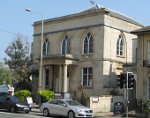 Born in 1768 in Bushey, Herts, the fifth child of Richard Capper and
Mary Ord, he married Mary Ann Jenkinson in 1810. Although described
above as a Hertfordshire magistrate, he was in the process of settling
in Cheltenham, at Marle Hill House (now demolished), above Pittville
Park, where the millpond was known as 'Capper's Fish Pond'. Appointed
to both the Shadwell and Hatton Garden courts, his main interests therefore lay
elsewhere; he was appointed a Cheltenham magistrate in 1821. A wealthy man, and a Calvinist, in 1816 he built the
Portland (North Place) Chapel in Cheltenham [left] and appointed a
Baptist minister, Thomas Snow, who refused communion to Capper and anyone else
who hadn't been baptized there. In retaliation Capper refused to pay
Snow’s salary (who had to hold services at his own home instead), and
three years later gave the chapel to the Countess of Huntingdon’s Connexion.
The building still stands, but has had various commercial uses and is
currently a fitness club. Capper was also involved, with fellow
Cheltenham magistrates Joseph Overbury and the Revd T.B. Newell DD, in
the Holyoake heresy trial (Judge Cluer, of Whitechapel County Court, later corresponded with Holyoake). He died in 1851 at Cheltenham, aged 83, the oldest
member of the bench there.
Born in 1768 in Bushey, Herts, the fifth child of Richard Capper and
Mary Ord, he married Mary Ann Jenkinson in 1810. Although described
above as a Hertfordshire magistrate, he was in the process of settling
in Cheltenham, at Marle Hill House (now demolished), above Pittville
Park, where the millpond was known as 'Capper's Fish Pond'. Appointed
to both the Shadwell and Hatton Garden courts, his main interests therefore lay
elsewhere; he was appointed a Cheltenham magistrate in 1821. A wealthy man, and a Calvinist, in 1816 he built the
Portland (North Place) Chapel in Cheltenham [left] and appointed a
Baptist minister, Thomas Snow, who refused communion to Capper and anyone else
who hadn't been baptized there. In retaliation Capper refused to pay
Snow’s salary (who had to hold services at his own home instead), and
three years later gave the chapel to the Countess of Huntingdon’s Connexion.
The building still stands, but has had various commercial uses and is
currently a fitness club. Capper was also involved, with fellow
Cheltenham magistrates Joseph Overbury and the Revd T.B. Newell DD, in
the Holyoake heresy trial (Judge Cluer, of Whitechapel County Court, later corresponded with Holyoake). He died in 1851 at Cheltenham, aged 83, the oldest
member of the bench there.
Henry Gregg
Described as a gentleman, he
had been Under Sheriff of London and Middlesex (paid £1,090 a year,
according to the House of Commons Journal for 1777 - rather more than
others in similar offices); his family came from Ilkeston in Derbyshire.
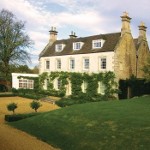
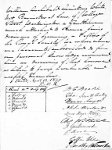 William Archibald Armstrong White FRS FSA (1816-21)
William Archibald Armstrong White FRS FSA (1816-21)
Born
1776, son of the Revd Dr Stephen White, he was a pupil of Westminster School, and was called to the bar at Lincoln's
Inn in 1801, becoming a police magistrate in 1816, in the house of Henry Gregg at Shadwell until its closure, and also at Queen Street, Westminster until his death, giving evidence to a House of Commons enquiry on drunkenness in 1834. He was an antiquarian - co-editing Hayward Townshend's 1601 House of Commons diary,
and an elected Fellow of the Royal Society (1837) - left is his nomination paper; a Fellow of the
Society of Arts; and member of the Camden Society
(for the publication of texts - not to be confused with the Cambridge
Camden Society for ecclesiastical architecture, or the present-day
society for people with learning difficulties). A coin collector, hee
was an early member of
the Numismatic Society
(established in 1836, meeting monthly
back-to-back with the Society of Antiquaries, with modest charges: a
guinea membership, and a guinea entrance). Sothebys printed a catalogue
of his collection in 1848, and the British Museum holds some
of his collection.
He lived in College Street, Westminster (where he died in 1847) and
Castor House, Peterborough [right],
a 3-storey house rebuilt around 1700 which his father, having inherited
a fortune, bought from the church (it possibly had some episcopal
connections) in 1796. bought from the church Northants (which he
inherited in 1824,
family having bought from church). A
son, the Revd Stephen Prescott White LLD, of St Peter's College Oxford
an equity barrister, draftsman and conveyancer, did much work on the
house, and was Treasurer of the Foundling Hospital (as his
great-grandfather had been) from 1830-41. A bachelor, he adopted the
six children of his deceased brother Charles. The house subsequently
passed out of the family.
Thames Police Office / Court (1796-)
The magistrates of
the Thames Police Office at 259 Wapping High Street were initially
designated 'special justices' because of their
river jurisdiction - more details here;
by 1844 this special jurisdiction was dispersed, and as a result of
mergers and boundary changes the court moved to Stepney; its
present-day successor, the Thames Magistrates Court, is in Bow Road.
Patrick Colquhoun (1792-1820)
John Harriott (1792-1816)
William Bragge whose family was from Sadborow in Dorset
William Kinnaird (-1821) - at the time of his death, aged 66, he had become the senior magistrate; obituaries described him as highly respectable, though a letter to The Times in 1828 says dismissively he kept a little chemist's shop in Holborn.
John Longley (18??-22)
A merchant's son, born at Chatham in 1749, he was called to the bar at
Lincoln's Inn in 1772. A political writer, in 1784 he was appointed
Recorder of Rochester, resigning in 1803, and was appointed to the
Thames Police Court at some point later, remaining in office until his
death in 1822. The previous year saw the closure of the Shadwell
office, consequent on the 1821 Act for the more effectual Administration of the Office of a Justice of the Peace in and near the Metropolis
which took up his suggestion that magistrates should be given authority
to suspend or dismiss incompetent or corrupt parish watchmen or
patrols. (It also set a 40-year age limit on apppointment to these
offices.)


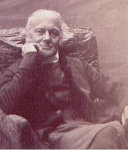
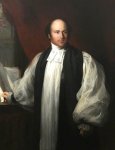 He
lived, with his wife Elizabeth (whom he married in Battersea in 1773)
and their seventeen children, at Angley House, near Cranbrook,
Tonbridge [first left - by Thomas Downes Wilmot Dearn, 1814], and then at Satis House, Boley Hill, near Rochester Castle [second left] - which now houses the administrative offices of King's School Rochester;
its name allegedly came from the comment of Queen Elizabeth I who
stayed at a previous incarnation of the house and when asked if she had
been comfortable, replied satis - OK. (Dickens knew the house, and it gave its name to Miss Havisham's house in Great Expectations.) His sixteenth child, Charles Thomas Longley, became Archbishop of Canterbury in 1862 [right].
He
lived, with his wife Elizabeth (whom he married in Battersea in 1773)
and their seventeen children, at Angley House, near Cranbrook,
Tonbridge [first left - by Thomas Downes Wilmot Dearn, 1814], and then at Satis House, Boley Hill, near Rochester Castle [second left] - which now houses the administrative offices of King's School Rochester;
its name allegedly came from the comment of Queen Elizabeth I who
stayed at a previous incarnation of the house and when asked if she had
been comfortable, replied satis - OK. (Dickens knew the house, and it gave its name to Miss Havisham's house in Great Expectations.) His sixteenth child, Charles Thomas Longley, became Archbishop of Canterbury in 1862 [right].
Captain Thomas Richbell RN (1816/17-33)
His remarkable life naval career was described in the 1833 obituary in the Gentleman's Magazine:
Captain Richbell entered the Navy at the age of nine years under the
care of his uncle, Lieut. Edward Woodnoth, and served with his present
Majesty in the West Indies. For the gallantry and bravery he displayed
in several actions and hazardous engagements, he was successively
promoted to the rank of Midshipman, Lieutenant 1780 (before attaining
his eighteenth year), Commander 1789, and Post Captain 1802. In the
year 1792 or 1793 he was appointed regulating Captain of the Volunteer
and Impressment department, in the metropolis, and to the charge of the
Enterprise tender ship off the Tower; and until the close of the war he
performed the onerous duties of his office to the satisfaction of the
government. He continued in this situation until the beginning of the
year 1817, when he was appointed by Lord Sidmouth. then Home Secretary,
to the office of a Thames police Magistrate, with the privilege of
retaining his half-pay. He has left a widow, who has been for some time
labouring under a severe indisposition, and a son and daughter under
age, to deplore the loss of a kind husband and most affectionate
father. Captain Richbell was a gentleman of very frugal habits, and his
property, which consists of freehold and leasehold estates, and money
in the funds, is said to be very considerable. Several of the
productions of his pencil have been exhibited at the Royal Academy
[of which he was an honorary member].
Capt Richbell's remains were interred on the 2d of May, in the vault
beneath the parish church of Wapping. The hearse, drawn by four horses,
was followed by three mourning coaches, containing the deceased's son,
a youth aged 15, Mr. Drinkald, a Ruler of the Waterman's Company, and
Mr. Baxter, the executors Mr. Broderip, one of the Thames Police
Magistrates, Mr. Symons, the Chief Clerk, Captain Cooke, R.N., Dr.
Hackness and Dr. Blake. |
He
succeeded
Herriott at the Thames court, and lived at Muscovy Court, Tower
Hill (a 'good' address at the time - demolished 1913-14 for the Port of
London Authority's offices). He died at his office in Wapping High
Street, aged 70. A nephew
Francis Edward Collingwood served as a midshipman with Nelson on HMS Victory.
William Ballantine (1821-48)
Called to the bar at the Inner Temple in 1813, having the previous year completed his magnum opus A Treatise on the Statute of Limitations,
his chambers were at Serjeant's Inn, Fleet Street. He became the senior magistrate of the Thames police with control over
the river police force; he died, aged 73, at Cadogan Place, Chelsea in
1852. His son William Ballantine
(1812-87), one of the last of the Serjeants-at-Law (the title was
abolished in the reforms of 1873) perhaps received the largest barrister's fee to
date in 1875 (5,000 guineas plus the same in fees) for defending an
Indian prince, Mulhar Rao, the Gaikwur of Baroda, on charge of
poisoning Colonel Phayre, the British Resident. He also acted in the
Tichbourne claimant case. His Experiences of a Barrister's Life were published the year after his death.
William John Broderip FRS &c (1822-46)
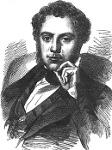 Born in 1789, eldest
son of a Bristol surgeon, he was educated locally and graduated from
Oriel College Oxford in 1812, having attended the anatomical lectures
of Sir Christopher Pegge, and the chemical and mineralogical lectures
of Dr. John Kidd. He was called to the Bar from the Inner Temple in
1817 and served on the western circuit - also editing, with Peregrine
Bingham, Reports from the Court of Common Pleas
(3 vols, 1820-22). Appointed in 1822 by Lord Sidmouth as a police
magistrate, transferring to Westminster in 1846, he continued in office
until compelled to resign because of deafness in 1856. In 1824 he had
edited the 4th edition of Robert Callis on the Statute of Sewers
(lectures first delivered in 1622 - combining his antiquarian and legal
interests). He was elected a bencher of Gray's Inn in 1850 (and
treasurer the following year), taking charge of the library.
Born in 1789, eldest
son of a Bristol surgeon, he was educated locally and graduated from
Oriel College Oxford in 1812, having attended the anatomical lectures
of Sir Christopher Pegge, and the chemical and mineralogical lectures
of Dr. John Kidd. He was called to the Bar from the Inner Temple in
1817 and served on the western circuit - also editing, with Peregrine
Bingham, Reports from the Court of Common Pleas
(3 vols, 1820-22). Appointed in 1822 by Lord Sidmouth as a police
magistrate, transferring to Westminster in 1846, he continued in office
until compelled to resign because of deafness in 1856. In 1824 he had
edited the 4th edition of Robert Callis on the Statute of Sewers
(lectures first delivered in 1622 - combining his antiquarian and legal
interests). He was elected a bencher of Gray's Inn in 1850 (and
treasurer the following year), taking charge of the library.
His great
passion was natural history, and his collection of shells, which many
foreign professors inspected in his chambers at Gray's Inn, was later
purchased by the British Museum. He was elected a fellow of the Linnean Society in 1824, of the Geological Society in 1825 (of which for a time he was Secretary), and the Royal Society in 1828; and with Sir Stamford Raffles was one of the original fellows of the Zoological Society in 1820, contributing many papers, particularly on malacology (the study of molluscs) to its Proceedings, and co-writing a guide to its gardens in 1829. Among other writings was Hints for Collecting Animals and their Products (1832), 'Account of the Manners of a Tame Beaver' (Gardens and Menagerie of the Zoological Society); Zoological Recreations (1847) and Leaves from the Note-book of A Naturalist (1852) - both collections of items for the New Monthly Magazine and Fraser's Magazine; the zoological articles in the Penny Cyclopædia
from Ast to the end (mammals, birds, reptiles, Crustacea, mollusca,
conchifera, cirrigrada, pulmagrada, &c); his last publication was
'On the Shark' (Fraser's Magazine 1859): he died, in his chambers, of apoplexy that year. Posthumously, a historical introduction to R. Owen's Memoir of the Dodo appeared in 1861.
John Beswicke Greenwood (1833-??)
Born in Dewsbury
in 1797, he was a magistrate (later chairman of the West Riding
Sessions) there as well as in London. The family home was at Moor
Bottom in that town, and they inherited the Purlwell estate. In 1842 he
arranged for William Hall, parish constable and overseer at Batley -
later
Superintendent of the West Riding Constabulary - to receive a £50
government reward for apprehending the
local leaders of the Chartist-inspired general strike, known at the Plug Riots. Isaac Binns,
a writer on dialect and borough treasurer of Batley, regarded 'old
Beswick' as responsible for the unpaved, rutted and muddy roads of
'mucky Batley'. In 1859 Greenwood published The Early Ecclesiastical History of Dewsbury.
In London, he sat at the Thames court, with Combe; at Clerkenwell from 1837 in the house of Clarkson;
and at Bow Street and Hatton Garden from 1839. His London home (with
his married sister Grace) was at 18 Woburn Square. In his 1843 evidence to the House of Lords Select Committee on Defamation and Libel he observed I
think a great deal of matter in the shape of police reports gets into
the newspapers, which must be shocking to ladies, who occasionally must
fall into it without being aware of it. He died in 1879, leaving most of his wealth to William Carr, surgeon, magistrate and antiquary.
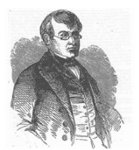
 Boyce Combe (1833-36 and Lambeth Street 1836-39)
Boyce Combe (1833-36 and Lambeth Street 1836-39)
1789-1864, one of the ten children of Harvey Christian Combe
of Cobham Park Surrey, Whig politician and MP for the City of London
and Lord Mayor 1799. Educated at Harrow, he became a bencher of Gray's
Inn, and was appointed to the Thames Police Court in 1833, in the house of the late Capt. Richbell, and then to Lambeth Street in 1836, in the house of the late Thomas Walker, and then to Hatton Garden in 1839. In 1815 he married a cousin Caroline,
sole heiress of the Revd Evan Jones of Trewythen, Montgomery, an old
Welsh family (she died in 1881). Their family lived at Hill House,
Speltham Hill, Hambledon, Hampshire (listed Grade II in 1987); he was a
member of the Athenæum and Reform Clubs, with a London address at 43
Upper Seymour Street. See here for a case of 1838 involving speed limits on the Thames. In R. v. Boyce Combe and the Churchwardens of St Andrew Holbon ex parte Loader (1849) QB 11 (NS) 179
the Queen's Bench considered a case where churchwardens had refused to
make a payment of 20s. to Loader, keeper of the 'second engine', for
attending a fire, under sections 76 and 77 of the Fires Prevention (Metropolis) Act 1774.
They argued that they had discretion to make a payment for this amount
or to set another figure, and had declined to do either because there
were at that time a number of wasteful rewards being paid; and Combe
argued that he had no jurisdiction to order payment unless it was
originated by the wardens. The law was unclear, but the three judges
held that the magistrate did have discretion to set and sanction a
payment.
His son, Major Boyce Harvey Combe of Oaklands, Battle, Sussex, a cavalry
officer in the Honourable East India Company cavalry and Major Commanding 1st Battalion Cinque Ports
Rifle Volunteers, became a JP for Sussex.
Thomas Clarkson (1836-37)
The only son of the famous Thomas Clarkson,
nonconformist anti-slavery campaigner (1760-1846), he was born in
Whitby, and educated at Bury St Edmunds and Trinity College Cambridge,
and called to the bar at the Middle Temple. He became a pleader on the
northern circuit, and - like a number of others of the period - a
'revising barrister', reviewing and adjudicating on electoral registers
in the wake of extensions of the franchise in 1832. He was kept busy in
Leeds, with over 4,000 objections, and determined that the non-payment
of the one shilling registration fee was not a disqualifying factor.
(Around this time, fellow-revisers determined, among other things, that
the franchise extended to dissenting ministers if they held lifelong
appointments; to dissenting trustees who received pew rents; and to
those who held a freehold right to pews in parish churches under an Act
of Parliament, but not others.) When the great theologian Frederick Denison Maurice
resolved to deal with his doubts about ordination (rejecting the narrow
Unitarianism of his father but troubled by the requirements of Anglican
subscription) by training as a barrister, at Trinity Hall Cambridge and
in London, Thomas Clarkson offered him a free pupillage. He was a
friend of Charles Lamb and his sister Mary Lamb (literary associates of Coleridge and
Wordsworth) and features in their letters. Appointed to succeed Combe
in 1836, he was killed in carriage accident the following year, aged 40.
Five of the following justices were appointed from the Oxford circuit.
Edward Yardley (1846-60)
The eldest son
Edward Yardley of Shrewsbury, he was born in Paley, Shropshire in 1804.
After Shrewsbury School, he went to Magdalen College Cambridge, where
he was the 40th and last wrangler
and a Fellow from 1830-2; in that year he married Elizabeth Taylor of
Everley, near Scarborough. Admitted to the Bar at Lincoln's Inn in
1834, he was appointed a stipendiary magistrate in 1846, moving four
years later to Marylebone to fill the vacancy caused by the death of
Isaac O. Seeker. (There he was a member of the parish vestry, and
became embroiled in a long-standing antipathy with the assistant
overseer of poor relief.) It is said that his decisions on river law
were scarcely ever challenged: one example of this jurisdiction is his
involvement in 1856 over the collision of the Josephine Willis and the Mangerton steamer. He gave evidence to the Select Committee on Poor Law Relief in 1861.
He was the elder
brother of Sir William Yardley (1810-78), of the Middle Temple, who was
made a puisne judge of the Bombay supreme court in 1847, was knighted,
and became chief justice 1852-58; on his return to England he was an
unsuccessful parliamentary candidate, and died in 1878. And he was the
father of Edward, also of the Middle Temple, who practised for a time
in Bombay alongside his uncle (and was clerk of the insolvent debtors'
court). It was to the son, rather than the father (contrary to the
claims of one source) that Charles Dickens wrote in 1868, acknowledging
the receipt of a package of books, since Edward died at his home at 8
Blandford Square in 1866 after a long illness.
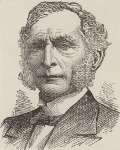
 Sir James Taylor Ingham (1850s)
Sir James Taylor Ingham (1850s)
Born in Mirfield, West Yorkshire in 1805, younger son of
Joshua Inham of Blake Hall, he attended school in Richmond, Yorkshire,
and Trinity College Cambridge. After his time at the Thames Court in
the 1850s, he became chief magistrate of Bow Street. Right is Sir Leslie Ward's Vanity Fair
cartoon of 1886, and an illustration for The Graphic in 1890 - the year of his death.
Henry Selfe Selfe [sic] 1856-63
Born at Rose Hill, near Worcester, in 1810, he changed his surname from
Page to inherit his maternal grandmother's property at Trowbridge,
Wiltshire. He studied at Glasgow University and was called to the Bar
in 1834, practising on the Oxford circuit and the Parliamentary Bar
until his appointment to the Thames Court in 1856. Here he was
associated with Colonel ffrench and Aspinall Turner on the Weedon Commision
inquiring into the state of the Army Clothing Department and
defalcations in war stores sent to the Crimea. He transferred to the
Westminster Court in 1863 until his death in 1870, from chronic gout.
He was said to be astute and fair-minded, leavening his judgements with
common sense and wit. He was a governor of Rugby School.
In 1840 he married Anna Maria, eldest daughter of William Spooner,
Archdeacon of Coventry and Rector of Elmdon, near Rugby; her sister
married Archibald Tait, who was Bishop of London at the time of the
Ritualism Riots
at St George-in-the-East and later became became
Archbishop of Canterbury. (In 1860 he tried at least two of the cases for disturbance that came before his court - nowadays he would probably be expected to declare an interest and recuse himself.nowadays he would have been expected to recuse
himself because of a personal connection - compare Dame Elizabeth Butler-Sloss
standing down from the 'historic' child abuse enquiry in 2014 because
her late brother, Lord Havers, had been Attorney-General at the time
when key decisions were made. But such scruples did not apply then.) They lived at 15 St George's Square [West,
rather than East, End!] and had three daughters and four sons
(one of whom, Sir William Lucius Selfe (1845-1924) became a county
court judge and was for a time the principal Secretary to Lord Cairns,
the Lord Chancellor).
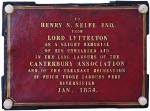 Selfe was active in the Canterbury Association, promoting settlement to New Zealand (where another son, James, went to live; another relative, Charles Henry Selfe Matthews (1873-1961), was a priest serving with the Bush Brotherhood in Australia in the early years of the next century). Right is a presentation casket from Lord Lyttleton of 1854. He
used his contacts and knowledge of the principal settlers to help the
colony get established. He became honorary London agent for the
Provincial Government, but resigned in 1866 because he felt compromised
by misinformation about a railway loan, whereupon he was given an
honorarium of £500 by the government, with which he bought a plot of
100 acres at Heathcote, travelling out to Canterbury with Lord
Lyttleton in 1866-67. He was a director of the London Board of the New
Zealand Trust and Loan Company. He had hoped to be appointed to a
judgeship there, and there is much correspondence on the matter, but Henry Barnes Gresson was appointed instead.
Selfe was active in the Canterbury Association, promoting settlement to New Zealand (where another son, James, went to live; another relative, Charles Henry Selfe Matthews (1873-1961), was a priest serving with the Bush Brotherhood in Australia in the early years of the next century). Right is a presentation casket from Lord Lyttleton of 1854. He
used his contacts and knowledge of the principal settlers to help the
colony get established. He became honorary London agent for the
Provincial Government, but resigned in 1866 because he felt compromised
by misinformation about a railway loan, whereupon he was given an
honorarium of £500 by the government, with which he bought a plot of
100 acres at Heathcote, travelling out to Canterbury with Lord
Lyttleton in 1866-67. He was a director of the London Board of the New
Zealand Trust and Loan Company. He had hoped to be appointed to a
judgeship there, and there is much correspondence on the matter, but Henry Barnes Gresson was appointed instead.
Like
Lord Lyttleton (who was president of the British Chess Association), he
was a chess player, and involved in the establishment and running of
the Westminster Chess Club, formed in the 1860s when the Cigar Divan
was converted into a dining room. A correspondent of 1873 to the Westminster Papers comments
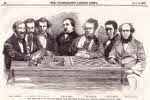 ... The Divan was thirty years old. It was known to and visited by all the
Chess world. It was one of the sights of London, and the admission was
but sixpence. The establishment was well conducted, and the members
behaved as gentlemen. The Divan being converted into a Dining room, and
the Chess room provided in its place not giving the accommodation that
the Chess players expected, they resolved to start a Club. The starting
a Club necessitated Whist, and Whist, containing the element gambling,
smothered Chess; so much so that, unless an effort of some sort be made
to revive Chess, the Club as a Chess Club will cease to exist. I am not
at all sure that it is advisable to attempt this revival, because, with
all deference to such as you who support Chess with your purse and
brains, the professional Chess players have been much too pampered ever
to have a healthy existence. I think it would be much better to let
Chess alone until the Chess players find their own level. The Club
still has amongst its members some of our most brilliant players; but
as my letter is for the Whist department, I daresay you will think I
have said more than enough on this subject ... [Left is an 1855 illustration of Lyttleton and other chess players.] ... The Divan was thirty years old. It was known to and visited by all the
Chess world. It was one of the sights of London, and the admission was
but sixpence. The establishment was well conducted, and the members
behaved as gentlemen. The Divan being converted into a Dining room, and
the Chess room provided in its place not giving the accommodation that
the Chess players expected, they resolved to start a Club. The starting
a Club necessitated Whist, and Whist, containing the element gambling,
smothered Chess; so much so that, unless an effort of some sort be made
to revive Chess, the Club as a Chess Club will cease to exist. I am not
at all sure that it is advisable to attempt this revival, because, with
all deference to such as you who support Chess with your purse and
brains, the professional Chess players have been much too pampered ever
to have a healthy existence. I think it would be much better to let
Chess alone until the Chess players find their own level. The Club
still has amongst its members some of our most brilliant players; but
as my letter is for the Whist department, I daresay you will think I
have said more than enough on this subject ... [Left is an 1855 illustration of Lyttleton and other chess players.]
|
See here
for a chess champion who was curate at St George-in-the-East in 1866.
Lord Lyttleton committed suicide in 1876 following bouts of insanity.
Edmund Humphr(e)y Woolrych (1862-64)
The
eldest son of Josiah Woolrych and an Italian mother, of
Monastier, in Lombardy, and from a family which produced several
lawyers (a relative Humphry William Woolrych
was a Serjeant-at-Law and a prolific writer of legal textbooks), he was
called to the Bar at the Middle Temple in 1839. Prior to his
appointment as a magistrate, he played a key role in the early years of
the Metropolitan Board of Works, created by Sir Benjamin Hall's Metropolis Local Management Act
of 1855 (later revised). It started with a staff of about 50 and an
annual wage bill of £25,000, but this increased markedly. The Board
itself had 45 members, elected from the various vestries (unpaid), and
was efficiently chaired for fifteen years by Sir John Thwaites, a Strict and Particular Baptist
from Westmorland but who had adapted to 'London ways' (and was paid,
something between £1000 and £2000 a year), and had an outstanding
engineer in the famous Joseph Bazalgette.
But - partly because (although its offices were at the former
Commissioners of Sewers premises in Greek Street) its meetings were
held in the Guildhall, with many members of the public in the gallery -
the workings of what was variously dubbed the 'Senate of Sewers',
'Parliament of Parishes' or 'Metropolitan Board of Words' tended to be
long-winded; and it later became open to charges of corruption.
Woolrych was one of 22 candidates for the post of clerk - he had been
secretary to the extinct Metropolitan Commissioners of Sewers; regarded
as a 'City man', but was, in the view of one commentator, a clerk of signal ability, who read his minutes with dispatch and paid close attention to debates.
Within four years he proposed that he should be appointed Legal Adviser
and Standing Counsel, and despite protests, this was done, at a salary
of £800. He had a point: drainage and street improvement schemes were
mounting in number and complexity, and when he moved on in 1861 the
Metropolitan Board of Works created a separate legal department, headed
by a solicitor. See further David Edward Owen The
Government of Victorian London, 1855-1889: The Metropolitan Board of
Works, the Vestries, and the City Corporation (Harvard 1982), and
Woolrych's own work The Metropolis Local Management Acts,
with introduction, notes and an appendix, containing statues
incorporated with the Metropolis Local Management Act 1855 or relating
to the functions fo the boards and vestries thereby constituted (Shaw & Sons 1863).
He
moved on to the Southwark court (and was replaced here by John Paget)
- giving evidence on the Sale of Liquors on Sunday Bill 1868 -
and then to Westminster; on leaving that post in 1880 he was made a JP
for Middlesex.
William Partridge (1863-69)

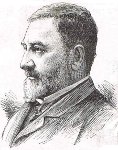 Born in 1818, the eldest son of John Partridge of Bishop's Wood,
Ross-on-Wye, Hereford, he attended Winchester College and was called to the Bar at
the Middle Temple in 1843 (though previously studied at Lincoln's Inn).
Two years earlier he
married Elizabeth Emily Webb, daughter of a Herefordshire magistrate.
He worked on the Oxford circuit before appointment as a stipendiary
magistrate in Wolverhampton in 1860, and tranferred to the Thames Court
in 1863. He moved on to Southwark, and then Marylebone; the
illustration right
is from the year of his death, 1891. Their London home was at 49
Gloucester Place, Hyde Park (his club was the Oxford & Cambridge),
and in Hereford at Wyelands (a large house built in the 1820s), near
Ross on Wye. Far right is a (much later) sign from their local station, Walford on the Ross and Monmouth Railway,
opened in 1873, of which he was a director. His eldest son Richard William was a barrister of the
Middle Temple, and a grandson R. Cecil Partridge became manager of the Central London Railway, aka the 'twopenny tube', which soon after became part of the Central Line.
Born in 1818, the eldest son of John Partridge of Bishop's Wood,
Ross-on-Wye, Hereford, he attended Winchester College and was called to the Bar at
the Middle Temple in 1843 (though previously studied at Lincoln's Inn).
Two years earlier he
married Elizabeth Emily Webb, daughter of a Herefordshire magistrate.
He worked on the Oxford circuit before appointment as a stipendiary
magistrate in Wolverhampton in 1860, and tranferred to the Thames Court
in 1863. He moved on to Southwark, and then Marylebone; the
illustration right
is from the year of his death, 1891. Their London home was at 49
Gloucester Place, Hyde Park (his club was the Oxford & Cambridge),
and in Hereford at Wyelands (a large house built in the 1820s), near
Ross on Wye. Far right is a (much later) sign from their local station, Walford on the Ross and Monmouth Railway,
opened in 1873, of which he was a director. His eldest son Richard William was a barrister of the
Middle Temple, and a grandson R. Cecil Partridge became manager of the Central London Railway, aka the 'twopenny tube', which soon after became part of the Central Line.
John Paget (1864-??)
Born in 1811 in Humberstone, Leicestershire, he was the son of banker
(Pares, Paget & Co in Leicester) and Whig (Liberal) politician Thomas Paget,
who was the first Mayor of the reformed Coropration of Leicester and
briefly MP for the county before the constituency was divided in 1832. Another son Thomas Tertius - with whom he had a bitter feud over their father's substantial estate - and John's own son Thomas Guy (heir of his childless uncle Thomas Tertius)
also served as Leicestershire MPs. John wrote some election material in support of his father's activities.The family were of Huguenot origin, descended from Valerian Paget who fled to England after the St Bartholomew's Day Massacre in France in 1572.
In 1834 John
married Elizabeth Rathbone, from a Liverpool Unitarian family active in
social reform - her brother and his daughter were both MPs. He joined the Reform Club when it was founded in 1836, and was a member of its library committee for 24 years and chairman from 1861-65. He was
called to the Bar in 1838 and served as secretary to Lord
Chancellors Truro and Cranworth from 1850-55, becoming a stipendiary
magistrate in 1864, succeeding John Paget when he transferred to Southwark.
Living at some points in and around Euston Square, but mainly at
23 The Boltons in West Brompton, John and Elizabeth had a son and two daughters, one of
whom was Dame Mary Rosalind Paget
(1855-1948), a nursing sister and campaigner for midwifery registration
and reform [which began with the 1902 Midwives Act], who was the first Superintendent, later Inspector General,
of the Queen's Jubilee Institute for District Nursing at the London
Hospital. He died in 1898. There
is more about the family's political involvement in the second half of this paper by R.H. Evans, including discussion of a letter from John to Guy.
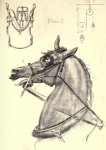 From 1860-88 he wrote regularly for Blackwood's Edinburgh Magazine.
His articles criticizing Macaulay's views of Marlborough, the massacre
of Glencoe, the highlands of Scotland, Claverhouse, and William Penn,
were reprinted as The New Examen (1861). Other articles on a wide range
of topics, including Nelson, Byron, well-known legal cases, and art,
appeared as Paradoxes and Puzzles: Historical, Judicial,
and Literary (1874). He was also a skilful draughtsman, and his illustrations to Edward Fordham Flower's Bits and
Bearing-Reins (1875) helped to show the cruelty to horses caused by this method of harnessing [example right].
The Pagets moved in artistic circles, and Elizabeth's collection of
family papers (now in the National Archive) includes letters to and
from well-known artists of the day.
From 1860-88 he wrote regularly for Blackwood's Edinburgh Magazine.
His articles criticizing Macaulay's views of Marlborough, the massacre
of Glencoe, the highlands of Scotland, Claverhouse, and William Penn,
were reprinted as The New Examen (1861). Other articles on a wide range
of topics, including Nelson, Byron, well-known legal cases, and art,
appeared as Paradoxes and Puzzles: Historical, Judicial,
and Literary (1874). He was also a skilful draughtsman, and his illustrations to Edward Fordham Flower's Bits and
Bearing-Reins (1875) helped to show the cruelty to horses caused by this method of harnessing [example right].
The Pagets moved in artistic circles, and Elizabeth's collection of
family papers (now in the National Archive) includes letters to and
from well-known artists of the day.
Following the publication of James Greenwood A Night in the Workhouse in the Pall Mall Gazette
(1866) and associated dramas, there was a spate of prurient middle
class fascination with workhouse life and its 'hideous enjoyments', and
two cases of people who had presented themselves at workhouses but had
money in their pockets (in breach of the rules) came to court. In the
first, which he claimed was a drunken spree, David Greenall was
released from Marlborough Street Police Court with a severe caution;
but in the second, heard by Paget at the Thames Police Court, a woman
ostentatiously arrived by cab at the Mile End Workhouse demanded
lodging in the casual ward, claiming that the Poor Law Board
regulations required them to take in all who claimed admission. She was
found to have 17s 7½d on her; and Paget sentenced her to a month's
hard labour in prison, exciting much press comment. (She
does not appear to have been a serious investigator of conditions,
unlike the 'destitute but once respectable' widow hired by medical
reformer Dr J.H. Stallard that same year to report on her findings at
four casual wards, including St George-in-the-East and Whitechapel,
which she did without titillation, but with terror of the ubiquitous
vermin, and convinced that cholera was generated every night - text here.)
But the previous year, according to Punch, he had been very kind as usual, and only bade her move on, when a well dressed young woman was charged with being tipsy and incapable of taking care of herself:
The
prisoner, who was attired in hat and feathers, a lace veil of fine
texture, a Paisley shawl worth at least four guineas, and a superb
flounced black silk dress said the unfortunate condition she was in was
all owing to the Underground Railway.
Mr Paget: What do you mean?
The Prisoner said she paid a visit to her brother and his wife
yesterday at Paddington and proceeded there and back by the Underground
Railway, which had such an effect upon her that sho became insensible.
Mr Paget: You were intoxicated.
Prisoner: Yes, I had one glass of gin, no more, after leaving the Underground Railway. I will never take any more.
Mr Paget: What are you?
Prisoner: A policeman's wife. He has been twenty years in the force. Oh,
Sir, it is all owing to the Underground Railway [Laughter].
|
A case where he sought to be helpful was reported in the Shipping Gazette, July 29, 1864:
George La Pierre, a seaman, came before Mr. Paget, at the Thames Police
Court, on Thursday, for redress under very singular circumstances. He
went out in the English ship Universe
to New York. One day he went on shore in New York with the third mate,
who got tipsy and made a noise. He was leading the third mate along
with the intention of returning to their ship when the Police
interfered, and took the third mate into custody and locked him up for
making a noise. At the same time several runners and crimps attacked
him and beat him, and having overpowered him took him to a house where
they kept him a close prisoner all night, and in the morning forced him
on board the American ship Caroline Nasmyth.
He was compelled to remain on board by the Captain and chief mate, to
whom he represented that he was the boatswain of the Universe, was
afflicted with a bad leg, and unable to do any hard work. The Captain
said he did not care about his leg, and that all he wanted was his
body; that he had paid men to bring him on board, and that he must work
on the voyage to England. He arrived in the Victoria Dock on Wednesday,
and asked for wages for his services. The Captain refused to pay him
anything, and he had now come on shore to seek redress and compensation
for a gross act of injustice and oppression.
Mr. Paget asked the applicant if he had signed any articles of agreement on board the Caroline Nasmyth,
to which he answered in the negative, and said he had no other clothes
but what he stood upright in. He came across the Atlantic Ocean without
a change of clothes and linen. In answer to further questions by the
magistrate, the applicant said all his clothes were on board the Universe, which had arrived at Liverpool. His wife had applied for his chest, hammock, and clothing on board the Universe,
at Liverpool, and the reply of the Captain was that he knew nothing
about them. Mr. Paget could not help thinking it was a very hard case
on the man. He was afraid he could not interfere in the matter. If the Caroline Nasmyth
was an English ship he would grant a summons for wages. He had no
jurisdiction over American ships. With regard to the clothes on board
the Universe he would
recommend La Pierre to write to his wife at Liverpool and direct her to
apply to Mr. Raffles, the stipendiary magistrate there, who would
render every possible assistance. The Applicant: What am I to do here?
I have no means of living, and no money. Mr. Paget advised the seaman
to wait on the American Consul and represent his grievances to him. The
seaman then left, and at 5 o'clock returned and said the American
Consul refused to give him any redress, and only laughed at him. The
consul threatened to have him arrested and sent back to the Caroline Nasmyth
again. Mr. Paget said that could not be done, and he would take care
the sailor was not arrested or kidnapped in his own country. He
directed Howland, a police constable, No. 89 H, who is attached to the
court, to take charge of the seaman, to provide him with food and a
lodging, and to make very particular inquiries into all the
circumstances of the case, and report to him the result. The applicant
then left with the officer. |
Ralph
Augustus Benson (?1867-69)
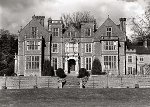 Born
in Hanley in 1828, son of Moses George Benson of Lutwyche Hall, near
Wenlock (the family home from the start of the 19th century - left), whose
grandfather Moses was a Liverpool merchant, probably involved in the
slave trade, and whose father Ralph was MP for Stafford. His
mother Charlotte Riou Browne was a
descendant,
several generations
back, of Mathieu Riou, member of the protestant congregation of
Vernoux in eastern France.
Ralph studied
at Christ Church, Oxford,
and was admitted to the Bar, practising in the Oxford circuit. He
stood unsuccessfully as a
Tory
candidate for the Wrekin Division of Shropshire,
and also for Reading..
Born
in Hanley in 1828, son of Moses George Benson of Lutwyche Hall, near
Wenlock (the family home from the start of the 19th century - left), whose
grandfather Moses was a Liverpool merchant, probably involved in the
slave trade, and whose father Ralph was MP for Stafford. His
mother Charlotte Riou Browne was a
descendant,
several generations
back, of Mathieu Riou, member of the protestant congregation of
Vernoux in eastern France.
Ralph studied
at Christ Church, Oxford,
and was admitted to the Bar, practising in the Oxford circuit. He
stood unsuccessfully as a
Tory
candidate for the Wrekin Division of Shropshire,
and also for Reading..
In
1867 he refused to make a conviction based on the evidence of a
ten-year old girl, although it was given in a
very clear and straightforward manner, and with an appearance of
great truth, since it was uncorroborated, and
a second girl who was present had not come forward, despite the case
being twice adjourned; furthermore, he had before him the character
witness of the incumbent of a large parish,
who had known the prisoner five years, and spoke of him as a well
conducted, respectable, and moral man.
Recognising that his action might be regarded as controversial
(because the evidence of a single witness was normally sufficient),
he said he hoped he was not doing wrong in the step he was about to
adopt. Punch
commented favourably on this remark: The really worthy
Magistrate may make up his mind on that point. He was not doing wrong
in refusing to convict on evidence which, whether true or false, was
insufficient. He was doing right. In so doing he certainly did what
was, as aforesaid, a very extraordinary thing, but will be, let us
hope, in good time an ordinary thing, as it will whenever Magistrates
in general get accustomed invariably to weigh evidence by the
standard of reason and justice. Mr Benson has shown them how to use
the scales.
 In
1869, according to the Daily News and The Times, Constable William
Smith was dismissed from the force and sentenced by Benson to a
month's hard labour for using excessive force in protecting a woman
abused by her husband - John Stuart Mill noted this case in
correspondence.Benson
was transferred to Southwark (working alongside William Partridge) on
the appointment of Sir Franklin Lushington.
In
1869, according to the Daily News and The Times, Constable William
Smith was dismissed from the force and sentenced by Benson to a
month's hard labour for using excessive force in protecting a woman
abused by her husband - John Stuart Mill noted this case in
correspondence.Benson
was transferred to Southwark (working alongside William Partridge) on
the appointment of Sir Franklin Lushington.
He
married Henrietta Cockerell in 1860 and they had three sons and two
daughters,
to one of whom, at St Peter Easthope in Shropshire (the local church of
Lutwyche Hall, rebuilt in Arts and Crafts style after a fire in 1928)),
there is a window in the chancel of 1933 [right] by the famous firm of Kempe (which closed the following year): In honour of Our Lord Jesus Christ, the King
of Martyrs, and of His Apostle St. Philip who suffered martyrdom on
the Cross, this window is dedicated as a memorial to Philippa Jessie,
daughter of Ralph Augustus Benson of Lutwyche, by George Reginald
Benson. A.D. mcmxxxiii.
He
was a member of Marylebone Cricket Club: his 'career' details are
here. He
contracted smallpox in 1871 but recovered, living until 1886 when he died in Marylebone.
Sir Franklin Lushington (1869-90)
Franklin (1822-1901) was the fourth
son of the 13 children of the Hon Edmund Henry Lushington, who among
other judicial posts was puisne judge of the Court of Ceylon (and whose
father was a well-known barrister). There were other lawyers in the
family, but ironically his older brother Edmund (1811-93), who was given the
middle name 'Law', was not one of them - he became a Professor of Greek
and Rector of Glasgow University. Franklin was named for a
distinguished naval captain ancestor of the previous century. He was a
pupil of Thomas Arnold at Rugby - one of the last, along with the Dean
of Westminster, to survive into the 20th century. After Trinity College
Cambridge, where he held scholarships and was a medal-winner,
graduating in 1846. he was called to the Bar at the Inner Temple in
1853. A spell in the diplomatic service brought him an
appointment from 1855-58 to the Supreme Council of Justice of the Ionian Islands
which were under British rule from 1815-62 - Bulmer Lytton, Secretary
of State for the Colonies, appointed him; Sir George Bowen was the
Governor; and Gladstone was for a time the High Commissioner, who
recommended that rule of the islands should be returned to Greece. Like
other lawyers, he did not feel specifically called to 'serve' abroad,
and not keen to leave home, but
it is necessary to have some definite work to do in place of the
prospect of spending the best years of one's life at home doing little
or nothing - a prospect common to most pursuers of the English bar at
the present (1855, to Whiiliam Whewell).

 In 1869 he became a metropolitan magistrate, with the Thames Police
Court as his first appointment, where he sat until 1890 (on a stipend
of £1500 a year), when he was transferred to Bow Street (the Central
Criminal Court), becoming chief magistrate - and knighted - in 1899
until his sudden death two years later. He was described as quiet and severe, and as fair and impartial; The Sketch said he would be remembered for his
capacity for giving the closest attention to every case, trivial as
some might be, and for a uniform kindliness towards all. [Right is
his memorial at St Mary Boxley, near Maidstone, and nearby Park House,
the family home: Tennyson had lived here for a time in 1841 when his
sister married into the family.]
In 1869 he became a metropolitan magistrate, with the Thames Police
Court as his first appointment, where he sat until 1890 (on a stipend
of £1500 a year), when he was transferred to Bow Street (the Central
Criminal Court), becoming chief magistrate - and knighted - in 1899
until his sudden death two years later. He was described as quiet and severe, and as fair and impartial; The Sketch said he would be remembered for his
capacity for giving the closest attention to every case, trivial as
some might be, and for a uniform kindliness towards all. [Right is
his memorial at St Mary Boxley, near Maidstone, and nearby Park House,
the family home: Tennyson had lived here for a time in 1841 when his
sister married into the family.]
An example of a 'trivial' case was a dispute in 1877 between members of a group known as the 'Social Trumps' - settle it among yourselves,
he told them. But he was involved in many high-profile criminal trials
- including, at the time of his death, the prosecution of Dr Frederick Edward Trangott Krause on charges of high treason and incitement to murder, in relation to the Boer War.
 He was jealous of the reputation of the police: Sir Leslie 'Spy' Ward (the caricaturist of Vanity Fair - image left, 1899)
provided the strapline 'He Believes in the Police'. When evidence
conflicted, he almost invariably accepted the police version, once
remarking I have had occasion for
many years to listen closely to evidence given by ihe police concerning
the persons they are brought into contact with. As compared with, other
witnesses they are, in nine cases out of ten, least likely to have made
a mistake, for it is part of their duty to cultivate a habit of
observation. But there were occasions when he dealt harshly with police defaulters.
He was jealous of the reputation of the police: Sir Leslie 'Spy' Ward (the caricaturist of Vanity Fair - image left, 1899)
provided the strapline 'He Believes in the Police'. When evidence
conflicted, he almost invariably accepted the police version, once
remarking I have had occasion for
many years to listen closely to evidence given by ihe police concerning
the persons they are brought into contact with. As compared with, other
witnesses they are, in nine cases out of ten, least likely to have made
a mistake, for it is part of their duty to cultivate a habit of
observation. But there were occasions when he dealt harshly with police defaulters.
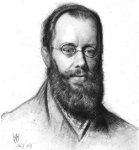 His
private life has been subject to some speculation. In 1848/49, when he was
in Malta (where his brother Henry was Government Secretary) he met Edward Lear [right];
they toured southern Greece together, and Lear developed an intense
passion for him, though wrote to his sister Anne in somewhat more guarded terms: My companion is
Mr. F. Lushington a very amiable & talented man – to travel with
whom is a great advantage to me as well as a pleasure. When Lushington went to the Ionian Islands
Lear joined him, making his home in Corfu, remaining there for many
years (together with his servant Giorgio Kokali) as he toured the
Mediterranean. (An aside: in Cannes Lear met old Harrovian, and
forthright advocate of male intimacy, John Addington Symonds, for whose
daughter Janet he wrote The Owl and the Pussycat. Some say Symonds
was implicated in the non-preferment of Harrow's headmaster, brother of
the vicar of St Mark Whitechapel - more details here. Symonds was also a friend from student days of Judge Cluer
of Whitechapel County Court).
His
private life has been subject to some speculation. In 1848/49, when he was
in Malta (where his brother Henry was Government Secretary) he met Edward Lear [right];
they toured southern Greece together, and Lear developed an intense
passion for him, though wrote to his sister Anne in somewhat more guarded terms: My companion is
Mr. F. Lushington a very amiable & talented man – to travel with
whom is a great advantage to me as well as a pleasure. When Lushington went to the Ionian Islands
Lear joined him, making his home in Corfu, remaining there for many
years (together with his servant Giorgio Kokali) as he toured the
Mediterranean. (An aside: in Cannes Lear met old Harrovian, and
forthright advocate of male intimacy, John Addington Symonds, for whose
daughter Janet he wrote The Owl and the Pussycat. Some say Symonds
was implicated in the non-preferment of Harrow's headmaster, brother of
the vicar of St Mark Whitechapel - more details here. Symonds was also a friend from student days of Judge Cluer
of Whitechapel County Court).
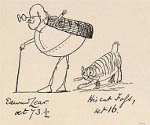 On Lear's last trip to England in 1880 he
stayed with the Lushingtons at their home at 33 Norfolk Square 9near Paddington Station), where he
put on an exhibition of his works. Lushington and others continued to
visit Lear at his Italian home in San Remo until his death in 1888, when Lushington wrote to Mrs Charles Street he has always
been the most charming & delightful of friends to me; & apart
from all his various qualities of genius, I have never known a man who
deserved more love for his goodness of heart & his determination to
do right; & I don’t think any human being knew him better than I
did. There never was a more generous or more unselfish soul. He
was the executor of Lear's estate - all his papers and paintings were
left to him, and the proceeds from the sale of 'Villa Emily' or 'Tennyson'
[named for the poet's wife] in San Remo and its contents were left to
Franklin's eldest daughter Louisa Gertrude. He
wrote the entry on Lear (and others) which appeared in the 1911 Encyclopædia Britannica.
On Lear's last trip to England in 1880 he
stayed with the Lushingtons at their home at 33 Norfolk Square 9near Paddington Station), where he
put on an exhibition of his works. Lushington and others continued to
visit Lear at his Italian home in San Remo until his death in 1888, when Lushington wrote to Mrs Charles Street he has always
been the most charming & delightful of friends to me; & apart
from all his various qualities of genius, I have never known a man who
deserved more love for his goodness of heart & his determination to
do right; & I don’t think any human being knew him better than I
did. There never was a more generous or more unselfish soul. He
was the executor of Lear's estate - all his papers and paintings were
left to him, and the proceeds from the sale of 'Villa Emily' or 'Tennyson'
[named for the poet's wife] in San Remo and its contents were left to
Franklin's eldest daughter Louisa Gertrude. He
wrote the entry on Lear (and others) which appeared in the 1911 Encyclopædia Britannica.
Was Lear's passion for Franklin Lushington ever reciprocated? Though
they remained friends for over forty years, the consensus is a fairly
firm 'no' - which was a source of torment to Lear, whose other
relationships were also fraught. Lushington had married Kate, a
clergyman's daughter, in 1862, and as noted above they had a family (their out-of-town
home was at Southborough, near Tunbridge Wells - in a house named
'Templechurch'). Yet he is listed in Keith Stern Queers in History: The Comprehensive Enclopedia of Historical Gays, Lesbians and Bisexuals (2013), with an inconclusive entry.
| In 1855, at the time of the Crimean War, he published a slim book of verse Wagers of Battle, writen by himself and his brother Henry. Henry was a close friend of the poet Tennyson - who wrote of him Three men have I loved, and / Thou art the last of the three - and a member of the Cambridge Apostles.
He was a Fellow of Trinity College, called to the Bar but not in
regular practice because of delicate health; appointed by Lord Grey as
chief secretary of the government of Malta, he was engaged in many
issues - police policy, law reform, education, and internal relgious
and other conflicts; he took a keen interest in the revolutionary
movements of 1848 and was symathetic to the French Republic, Italian Risorgimento
and Hungarian nationalism. He fell ill after seven years there and died
in Paris in 1855, Franklin rushing from Corfu to be with him. The book was republished, with additions, in 1899. Here is an extract from one
of the later poems, of dubious poetic but undoubted patriotic merit: |
Prayers—for strength to defend the right, through drifts of doubt, In trouble and stress,
Prayers—for wisdom to guide the helm—prayers for His grace to govern and bless:
Thanks—for valour of daughter nations, happy to press where their mother strives,
Eager to aid her, eager to shield her, loyally lending love and lives.
Hail, Australia! welcome, Canada! Greater Britain all round the wave,
Fight one fight and carry one banner, plant it firm on tyranny's grave.
Weld our kinship Into Empire—Empire based on the one true plan,
Freemen's rights and freemen's Justice broadening still between man and man.
Honestly wrought for, fearlessly fought for, spreading o'er land and spread aver sea,
Empire—born of a stern death-struggle, christened in blood of the brave and the free. |
He contributed to journals on various subjects:
- The Crisis of Italian Freedom (1859), The Growth of Italian Unity (1861)
- Plutarch's Lives [Clough's edition of Dryden's translation] 1860, Hannibal's Passage of the Alps (1867)
- William Wordsworth (1850), In Memoriam (1850), Memoirs of William Wordsworth [by Chistopher Wordsworth] 1851, The Times and the Poets (1852)
- Senior's Journal in Turkey & Greece (1859), Arctic Enterprise since 1815 (1860)
- History of Charles II [by C. J. Lyon] (1851), Lord Dundonald (1861)
Other Lushingtons were politicians, civil servants (including Privy Councillors) and had naval careers.
See separate page for a 20th century metropolitan magistrate: Francis Oswald Langley (1884-1947)
«« Policing and Courts | »» County Court judges | »» Judge Bacon | »» Judge Cluer



 was
the second son of Captain John Rogers, and descendant of Captain John
Rogers who gained distinction by repelling the assault of a Biscay
privateer on a transport ship under his commend in 1704. He was called
to the Bar at the Middle Temple in 1805, but his chambers were
subsequently at 5 Old Square, Lincoln's Inn and his home in Upper
Bedford Place, Russell Square, and later in Hampstead. He was appointed
a magistrate in 1813, sitting at Hatton Garden as well as in the local
courts, and was a member of Fellow of the (Royal) Society of Arts and subscriber to the [science-based] Royal Institution and a bibliophile - bookplate right (motto nos nostraque deo = we and ours to God);
his extensive library was auctioned the year aftert his death in 1838. For a few years, from
1812-15, he was an elected member of 'Nobody's Friends', a dining club
established in 1800 by Richard Stevens (a high churchman and Treasurer
of Queen Anne's Bounty); its influential membership overlapped with the
'Hackney Phalanx' (also known as the 'Clapton sect', as distinct from
the evangelical 'Clapham sect') which had a particular interest in
education reform.
was
the second son of Captain John Rogers, and descendant of Captain John
Rogers who gained distinction by repelling the assault of a Biscay
privateer on a transport ship under his commend in 1704. He was called
to the Bar at the Middle Temple in 1805, but his chambers were
subsequently at 5 Old Square, Lincoln's Inn and his home in Upper
Bedford Place, Russell Square, and later in Hampstead. He was appointed
a magistrate in 1813, sitting at Hatton Garden as well as in the local
courts, and was a member of Fellow of the (Royal) Society of Arts and subscriber to the [science-based] Royal Institution and a bibliophile - bookplate right (motto nos nostraque deo = we and ours to God);
his extensive library was auctioned the year aftert his death in 1838. For a few years, from
1812-15, he was an elected member of 'Nobody's Friends', a dining club
established in 1800 by Richard Stevens (a high churchman and Treasurer
of Queen Anne's Bounty); its influential membership overlapped with the
'Hackney Phalanx' (also known as the 'Clapton sect', as distinct from
the evangelical 'Clapham sect') which had a particular interest in
education reform. 


 This post was fixed by
his wife Caroline [right, by George Hayer 1832], daughter of the playwright Sheridan, and herself a considerable
writer - with Lord Melbourne, the Home Secretary. Not only was
she from a family with Whig connections, but also mistress of widower
and philanderer Melbourne [right, by Landseer 1836]. Norton, although he protested undying love
for his childhood sweetheart, was in fact an appallingly violent and
abusive husband; they separated three times, but she returned for the
children's sake. Norton sued Melbourne, who had become Prime
Minister, in attempt to achieve a divorce. Melbourne was acquitted, but
many rash words were spoken by all parties and no-one emerged smelling
of roses [title page of a published version right]. Dickens drew on the case - and the farcical way the lovers'
correspondence was treated in court - for his Pickwick Papers.
Norton then exonerated his wife in an attempt to win her back, and
thereafter denied her a divorce; further washing of dirty linen
followed, and she became a campaigner for women's matrimonial rights in
marriage - leading to the Custody of Infants Act 1839 [far right, by Etty after this Act], the Matrimonial Causes Act 1857 and the Married Women's Property Act
1870. Nevertheless, he continued to hold his magistracy, transferring
to the Lambeth court in 1854, until he retired because of 'failing
health' in
1867, with pension, after 36 years on the bench; he died in 1875.
This post was fixed by
his wife Caroline [right, by George Hayer 1832], daughter of the playwright Sheridan, and herself a considerable
writer - with Lord Melbourne, the Home Secretary. Not only was
she from a family with Whig connections, but also mistress of widower
and philanderer Melbourne [right, by Landseer 1836]. Norton, although he protested undying love
for his childhood sweetheart, was in fact an appallingly violent and
abusive husband; they separated three times, but she returned for the
children's sake. Norton sued Melbourne, who had become Prime
Minister, in attempt to achieve a divorce. Melbourne was acquitted, but
many rash words were spoken by all parties and no-one emerged smelling
of roses [title page of a published version right]. Dickens drew on the case - and the farcical way the lovers'
correspondence was treated in court - for his Pickwick Papers.
Norton then exonerated his wife in an attempt to win her back, and
thereafter denied her a divorce; further washing of dirty linen
followed, and she became a campaigner for women's matrimonial rights in
marriage - leading to the Custody of Infants Act 1839 [far right, by Etty after this Act], the Matrimonial Causes Act 1857 and the Married Women's Property Act
1870. Nevertheless, he continued to hold his magistracy, transferring
to the Lambeth court in 1854, until he retired because of 'failing
health' in
1867, with pension, after 36 years on the bench; he died in 1875. Sir Thomas
Henry (1840-46) - right:
an Irish Roman Catholic, born 1807, graduate of Trinity College Dublin, called to
the Bar at the Middle Temple in 1829, and after working on the northern
circuit was appointed to Lambeth Street in 1840, transferring in 1846
to Bow
Street, where he became chief magistrate. He was a principal architect
of the 1862 Extradition Act, and was a government adviser on licensing (theatres and pubs), betting, and Sunday trading.
Sir Thomas
Henry (1840-46) - right:
an Irish Roman Catholic, born 1807, graduate of Trinity College Dublin, called to
the Bar at the Middle Temple in 1829, and after working on the northern
circuit was appointed to Lambeth Street in 1840, transferring in 1846
to Bow
Street, where he became chief magistrate. He was a principal architect
of the 1862 Extradition Act, and was a government adviser on licensing (theatres and pubs), betting, and Sunday trading. Born in 1768 in Bushey, Herts, the fifth child of Richard Capper and
Mary Ord, he married Mary Ann Jenkinson in 1810. Although described
above as a Hertfordshire magistrate, he was in the process of settling
in Cheltenham, at Marle Hill House (now demolished), above Pittville
Park, where the millpond was known as 'Capper's Fish Pond'. Appointed
to both the Shadwell and Hatton Garden courts, his main interests therefore lay
elsewhere; he was appointed a Cheltenham magistrate in 1821. A wealthy man, and a Calvinist, in 1816 he built the
Portland (North Place) Chapel in Cheltenham [left] and appointed a
Baptist minister, Thomas Snow, who refused communion to Capper and anyone else
who hadn't been baptized there. In retaliation Capper refused to pay
Snow’s salary (who had to hold services at his own home instead), and
three years later gave the chapel to the Countess of Huntingdon’s Connexion.
The building still stands, but has had various commercial uses and is
currently a fitness club. Capper was also involved, with fellow
Cheltenham magistrates Joseph Overbury and the Revd T.B. Newell DD, in
the Holyoake heresy trial (Judge Cluer, of Whitechapel County Court, later corresponded with Holyoake). He died in 1851 at Cheltenham, aged 83, the oldest
member of the bench there.
Born in 1768 in Bushey, Herts, the fifth child of Richard Capper and
Mary Ord, he married Mary Ann Jenkinson in 1810. Although described
above as a Hertfordshire magistrate, he was in the process of settling
in Cheltenham, at Marle Hill House (now demolished), above Pittville
Park, where the millpond was known as 'Capper's Fish Pond'. Appointed
to both the Shadwell and Hatton Garden courts, his main interests therefore lay
elsewhere; he was appointed a Cheltenham magistrate in 1821. A wealthy man, and a Calvinist, in 1816 he built the
Portland (North Place) Chapel in Cheltenham [left] and appointed a
Baptist minister, Thomas Snow, who refused communion to Capper and anyone else
who hadn't been baptized there. In retaliation Capper refused to pay
Snow’s salary (who had to hold services at his own home instead), and
three years later gave the chapel to the Countess of Huntingdon’s Connexion.
The building still stands, but has had various commercial uses and is
currently a fitness club. Capper was also involved, with fellow
Cheltenham magistrates Joseph Overbury and the Revd T.B. Newell DD, in
the Holyoake heresy trial (Judge Cluer, of Whitechapel County Court, later corresponded with Holyoake). He died in 1851 at Cheltenham, aged 83, the oldest
member of the bench there.
 William Archibald Armstrong White FRS FSA (1816-21)
William Archibald Armstrong White FRS FSA (1816-21)


 He
lived, with his wife Elizabeth (whom he married in Battersea in 1773)
and their seventeen children, at Angley House, near Cranbrook,
Tonbridge [first left - by Thomas Downes Wilmot Dearn, 1814], and then at Satis House, Boley Hill, near Rochester Castle [second left] - which now houses the administrative offices of King's School Rochester;
its name allegedly came from the comment of Queen Elizabeth I who
stayed at a previous incarnation of the house and when asked if she had
been comfortable, replied satis - OK. (Dickens knew the house, and it gave its name to Miss Havisham's house in Great Expectations.) His sixteenth child, Charles Thomas Longley, became Archbishop of Canterbury in 1862 [right].
He
lived, with his wife Elizabeth (whom he married in Battersea in 1773)
and their seventeen children, at Angley House, near Cranbrook,
Tonbridge [first left - by Thomas Downes Wilmot Dearn, 1814], and then at Satis House, Boley Hill, near Rochester Castle [second left] - which now houses the administrative offices of King's School Rochester;
its name allegedly came from the comment of Queen Elizabeth I who
stayed at a previous incarnation of the house and when asked if she had
been comfortable, replied satis - OK. (Dickens knew the house, and it gave its name to Miss Havisham's house in Great Expectations.) His sixteenth child, Charles Thomas Longley, became Archbishop of Canterbury in 1862 [right]. Born in 1789, eldest
son of a Bristol surgeon, he was educated locally and graduated from
Oriel College Oxford in 1812, having attended the anatomical lectures
of Sir Christopher Pegge, and the chemical and mineralogical lectures
of Dr. John Kidd. He was called to the Bar from the Inner Temple in
1817 and served on the western circuit - also editing, with Peregrine
Bingham, Reports from the Court of Common Pleas
(3 vols, 1820-22). Appointed in 1822 by Lord Sidmouth as a police
magistrate, transferring to Westminster in 1846, he continued in office
until compelled to resign because of deafness in 1856. In 1824 he had
edited the 4th edition of Robert Callis on the Statute of Sewers
(lectures first delivered in 1622 - combining his antiquarian and legal
interests). He was elected a bencher of Gray's Inn in 1850 (and
treasurer the following year), taking charge of the library.
Born in 1789, eldest
son of a Bristol surgeon, he was educated locally and graduated from
Oriel College Oxford in 1812, having attended the anatomical lectures
of Sir Christopher Pegge, and the chemical and mineralogical lectures
of Dr. John Kidd. He was called to the Bar from the Inner Temple in
1817 and served on the western circuit - also editing, with Peregrine
Bingham, Reports from the Court of Common Pleas
(3 vols, 1820-22). Appointed in 1822 by Lord Sidmouth as a police
magistrate, transferring to Westminster in 1846, he continued in office
until compelled to resign because of deafness in 1856. In 1824 he had
edited the 4th edition of Robert Callis on the Statute of Sewers
(lectures first delivered in 1622 - combining his antiquarian and legal
interests). He was elected a bencher of Gray's Inn in 1850 (and
treasurer the following year), taking charge of the library.
 Boyce Combe (1833-36 and Lambeth Street 1836-39)
Boyce Combe (1833-36 and Lambeth Street 1836-39)
 Sir James Taylor Ingham (1850s)
Sir James Taylor Ingham (1850s) Selfe was active in the Canterbury Association, promoting settlement to New Zealand (where another son, James, went to live; another relative, Charles Henry Selfe Matthews (1873-1961), was a priest serving with the Bush Brotherhood in Australia in the early years of the next century). Right is a presentation casket from Lord Lyttleton of 1854. He
used his contacts and knowledge of the principal settlers to help the
colony get established. He became honorary London agent for the
Provincial Government, but resigned in 1866 because he felt compromised
by misinformation about a railway loan, whereupon he was given an
honorarium of £500 by the government, with which he bought a plot of
100 acres at Heathcote, travelling out to Canterbury with Lord
Lyttleton in 1866-67. He was a director of the London Board of the New
Zealand Trust and Loan Company. He had hoped to be appointed to a
judgeship there, and there is much correspondence on the matter, but Henry Barnes Gresson was appointed instead.
Selfe was active in the Canterbury Association, promoting settlement to New Zealand (where another son, James, went to live; another relative, Charles Henry Selfe Matthews (1873-1961), was a priest serving with the Bush Brotherhood in Australia in the early years of the next century). Right is a presentation casket from Lord Lyttleton of 1854. He
used his contacts and knowledge of the principal settlers to help the
colony get established. He became honorary London agent for the
Provincial Government, but resigned in 1866 because he felt compromised
by misinformation about a railway loan, whereupon he was given an
honorarium of £500 by the government, with which he bought a plot of
100 acres at Heathcote, travelling out to Canterbury with Lord
Lyttleton in 1866-67. He was a director of the London Board of the New
Zealand Trust and Loan Company. He had hoped to be appointed to a
judgeship there, and there is much correspondence on the matter, but Henry Barnes Gresson was appointed instead.
 Born in 1818, the eldest son of John Partridge of Bishop's Wood,
Ross-on-Wye, Hereford, he attended Winchester College and was called to the Bar at
the Middle Temple in 1843 (though previously studied at Lincoln's Inn).
Two years earlier he
married Elizabeth Emily Webb, daughter of a Herefordshire magistrate.
He worked on the Oxford circuit before appointment as a stipendiary
magistrate in Wolverhampton in 1860, and tranferred to the Thames Court
in 1863. He moved on to Southwark, and then Marylebone; the
illustration right
is from the year of his death, 1891. Their London home was at 49
Gloucester Place, Hyde Park (his club was the Oxford & Cambridge),
and in Hereford at Wyelands (a large house built in the 1820s), near
Ross on Wye. Far right is a (much later) sign from their local station, Walford on the Ross and Monmouth Railway,
opened in 1873, of which he was a director. His eldest son Richard William was a barrister of the
Middle Temple, and a grandson R. Cecil Partridge became manager of the Central London Railway, aka the 'twopenny tube', which soon after became part of the Central Line.
Born in 1818, the eldest son of John Partridge of Bishop's Wood,
Ross-on-Wye, Hereford, he attended Winchester College and was called to the Bar at
the Middle Temple in 1843 (though previously studied at Lincoln's Inn).
Two years earlier he
married Elizabeth Emily Webb, daughter of a Herefordshire magistrate.
He worked on the Oxford circuit before appointment as a stipendiary
magistrate in Wolverhampton in 1860, and tranferred to the Thames Court
in 1863. He moved on to Southwark, and then Marylebone; the
illustration right
is from the year of his death, 1891. Their London home was at 49
Gloucester Place, Hyde Park (his club was the Oxford & Cambridge),
and in Hereford at Wyelands (a large house built in the 1820s), near
Ross on Wye. Far right is a (much later) sign from their local station, Walford on the Ross and Monmouth Railway,
opened in 1873, of which he was a director. His eldest son Richard William was a barrister of the
Middle Temple, and a grandson R. Cecil Partridge became manager of the Central London Railway, aka the 'twopenny tube', which soon after became part of the Central Line. From 1860-88 he wrote regularly for Blackwood's Edinburgh Magazine.
His articles criticizing Macaulay's views of Marlborough, the massacre
of Glencoe, the highlands of Scotland, Claverhouse, and William Penn,
were reprinted as The New Examen (1861). Other articles on a wide range
of topics, including Nelson, Byron, well-known legal cases, and art,
appeared as Paradoxes and Puzzles: Historical, Judicial,
and Literary (1874). He was also a skilful draughtsman, and his illustrations to Edward Fordham Flower's Bits and
Bearing-Reins (1875) helped to show the cruelty to horses caused by this method of harnessing [example right].
The Pagets moved in artistic circles, and Elizabeth's collection of
family papers (now in the National Archive) includes letters to and
from well-known artists of the day.
From 1860-88 he wrote regularly for Blackwood's Edinburgh Magazine.
His articles criticizing Macaulay's views of Marlborough, the massacre
of Glencoe, the highlands of Scotland, Claverhouse, and William Penn,
were reprinted as The New Examen (1861). Other articles on a wide range
of topics, including Nelson, Byron, well-known legal cases, and art,
appeared as Paradoxes and Puzzles: Historical, Judicial,
and Literary (1874). He was also a skilful draughtsman, and his illustrations to Edward Fordham Flower's Bits and
Bearing-Reins (1875) helped to show the cruelty to horses caused by this method of harnessing [example right].
The Pagets moved in artistic circles, and Elizabeth's collection of
family papers (now in the National Archive) includes letters to and
from well-known artists of the day. Born
in Hanley in 1828, son of Moses George Benson of Lutwyche Hall, near
Wenlock (the family home from the start of the 19th century - left), whose
grandfather Moses was a Liverpool merchant, probably involved in the
slave trade, and whose father Ralph was MP for Stafford. His
mother Charlotte Riou Browne was a
descendant,
several generations
back, of Mathieu Riou, member of the protestant congregation of
Vernoux in eastern France.
Ralph studied
at Christ Church, Oxford,
and was admitted to the Bar, practising in the Oxford circuit. He
stood unsuccessfully as a
Tory
candidate for the Wrekin Division of Shropshire,
and also for Reading..
Born
in Hanley in 1828, son of Moses George Benson of Lutwyche Hall, near
Wenlock (the family home from the start of the 19th century - left), whose
grandfather Moses was a Liverpool merchant, probably involved in the
slave trade, and whose father Ralph was MP for Stafford. His
mother Charlotte Riou Browne was a
descendant,
several generations
back, of Mathieu Riou, member of the protestant congregation of
Vernoux in eastern France.
Ralph studied
at Christ Church, Oxford,
and was admitted to the Bar, practising in the Oxford circuit. He
stood unsuccessfully as a
Tory
candidate for the Wrekin Division of Shropshire,
and also for Reading..
 In
1869, according to the Daily News and The Times, Constable William
Smith was dismissed from the force and sentenced by Benson to a
month's hard labour for using excessive force in protecting a woman
abused by her husband - John Stuart Mill noted this case in
correspondence.Benson
was transferred to Southwark (working alongside William Partridge) on
the appointment of Sir Franklin Lushington.
In
1869, according to the Daily News and The Times, Constable William
Smith was dismissed from the force and sentenced by Benson to a
month's hard labour for using excessive force in protecting a woman
abused by her husband - John Stuart Mill noted this case in
correspondence.Benson
was transferred to Southwark (working alongside William Partridge) on
the appointment of Sir Franklin Lushington.

 In 1869 he became a metropolitan magistrate, with the Thames Police
Court as his first appointment, where he sat until 1890 (on a stipend
of £1500 a year), when he was transferred to Bow Street (the Central
Criminal Court), becoming chief magistrate - and knighted - in 1899
until his sudden death two years later. He was described as quiet and severe, and as fair and impartial; The Sketch said he would be remembered for his
capacity for giving the closest attention to every case, trivial as
some might be, and for a uniform kindliness towards all. [Right is
his memorial at St Mary Boxley, near Maidstone, and nearby Park House,
the family home: Tennyson had lived here for a time in 1841 when his
sister married into the family.]
In 1869 he became a metropolitan magistrate, with the Thames Police
Court as his first appointment, where he sat until 1890 (on a stipend
of £1500 a year), when he was transferred to Bow Street (the Central
Criminal Court), becoming chief magistrate - and knighted - in 1899
until his sudden death two years later. He was described as quiet and severe, and as fair and impartial; The Sketch said he would be remembered for his
capacity for giving the closest attention to every case, trivial as
some might be, and for a uniform kindliness towards all. [Right is
his memorial at St Mary Boxley, near Maidstone, and nearby Park House,
the family home: Tennyson had lived here for a time in 1841 when his
sister married into the family.] He was jealous of the reputation of the police: Sir Leslie 'Spy' Ward (the caricaturist of Vanity Fair - image left, 1899)
provided the strapline 'He Believes in the Police'. When evidence
conflicted, he almost invariably accepted the police version, once
remarking I have had occasion for
many years to listen closely to evidence given by ihe police concerning
the persons they are brought into contact with. As compared with, other
witnesses they are, in nine cases out of ten, least likely to have made
a mistake, for it is part of their duty to cultivate a habit of
observation. But there were occasions when he dealt harshly with police defaulters.
He was jealous of the reputation of the police: Sir Leslie 'Spy' Ward (the caricaturist of Vanity Fair - image left, 1899)
provided the strapline 'He Believes in the Police'. When evidence
conflicted, he almost invariably accepted the police version, once
remarking I have had occasion for
many years to listen closely to evidence given by ihe police concerning
the persons they are brought into contact with. As compared with, other
witnesses they are, in nine cases out of ten, least likely to have made
a mistake, for it is part of their duty to cultivate a habit of
observation. But there were occasions when he dealt harshly with police defaulters. His
private life has been subject to some speculation. In 1848/49, when he was
in Malta (where his brother Henry was Government Secretary) he met Edward Lear [right];
they toured southern Greece together, and Lear developed an intense
passion for him, though wrote to his sister Anne in somewhat more guarded terms: My companion is
Mr. F. Lushington a very amiable & talented man – to travel with
whom is a great advantage to me as well as a pleasure. When Lushington went to the Ionian Islands
Lear joined him, making his home in Corfu, remaining there for many
years (together with his servant Giorgio Kokali) as he toured the
Mediterranean. (An aside: in Cannes Lear met old Harrovian, and
forthright advocate of male intimacy, John Addington Symonds, for whose
daughter Janet he wrote The Owl and the Pussycat. Some say Symonds
was implicated in the non-preferment of Harrow's headmaster, brother of
the vicar of St Mark Whitechapel - more details here. Symonds was also a friend from student days of Judge Cluer
of Whitechapel County Court).
His
private life has been subject to some speculation. In 1848/49, when he was
in Malta (where his brother Henry was Government Secretary) he met Edward Lear [right];
they toured southern Greece together, and Lear developed an intense
passion for him, though wrote to his sister Anne in somewhat more guarded terms: My companion is
Mr. F. Lushington a very amiable & talented man – to travel with
whom is a great advantage to me as well as a pleasure. When Lushington went to the Ionian Islands
Lear joined him, making his home in Corfu, remaining there for many
years (together with his servant Giorgio Kokali) as he toured the
Mediterranean. (An aside: in Cannes Lear met old Harrovian, and
forthright advocate of male intimacy, John Addington Symonds, for whose
daughter Janet he wrote The Owl and the Pussycat. Some say Symonds
was implicated in the non-preferment of Harrow's headmaster, brother of
the vicar of St Mark Whitechapel - more details here. Symonds was also a friend from student days of Judge Cluer
of Whitechapel County Court). On Lear's last trip to England in 1880 he
stayed with the Lushingtons at their home at 33 Norfolk Square 9near Paddington Station), where he
put on an exhibition of his works. Lushington and others continued to
visit Lear at his Italian home in San Remo until his death in 1888, when Lushington wrote to Mrs Charles Street he has always
been the most charming & delightful of friends to me; & apart
from all his various qualities of genius, I have never known a man who
deserved more love for his goodness of heart & his determination to
do right; & I don’t think any human being knew him better than I
did. There never was a more generous or more unselfish soul. He
was the executor of Lear's estate - all his papers and paintings were
left to him, and the proceeds from the sale of 'Villa Emily' or 'Tennyson'
[named for the poet's wife] in San Remo and its contents were left to
Franklin's eldest daughter Louisa Gertrude. He
wrote the entry on Lear (and others) which appeared in the 1911 Encyclopædia Britannica.
On Lear's last trip to England in 1880 he
stayed with the Lushingtons at their home at 33 Norfolk Square 9near Paddington Station), where he
put on an exhibition of his works. Lushington and others continued to
visit Lear at his Italian home in San Remo until his death in 1888, when Lushington wrote to Mrs Charles Street he has always
been the most charming & delightful of friends to me; & apart
from all his various qualities of genius, I have never known a man who
deserved more love for his goodness of heart & his determination to
do right; & I don’t think any human being knew him better than I
did. There never was a more generous or more unselfish soul. He
was the executor of Lear's estate - all his papers and paintings were
left to him, and the proceeds from the sale of 'Villa Emily' or 'Tennyson'
[named for the poet's wife] in San Remo and its contents were left to
Franklin's eldest daughter Louisa Gertrude. He
wrote the entry on Lear (and others) which appeared in the 1911 Encyclopædia Britannica.